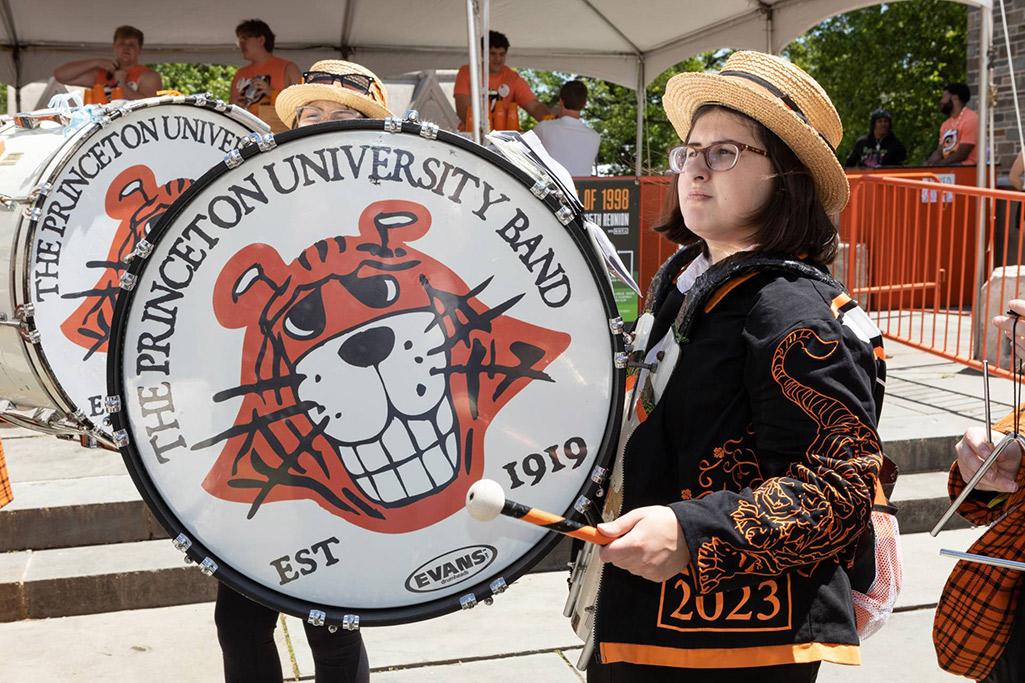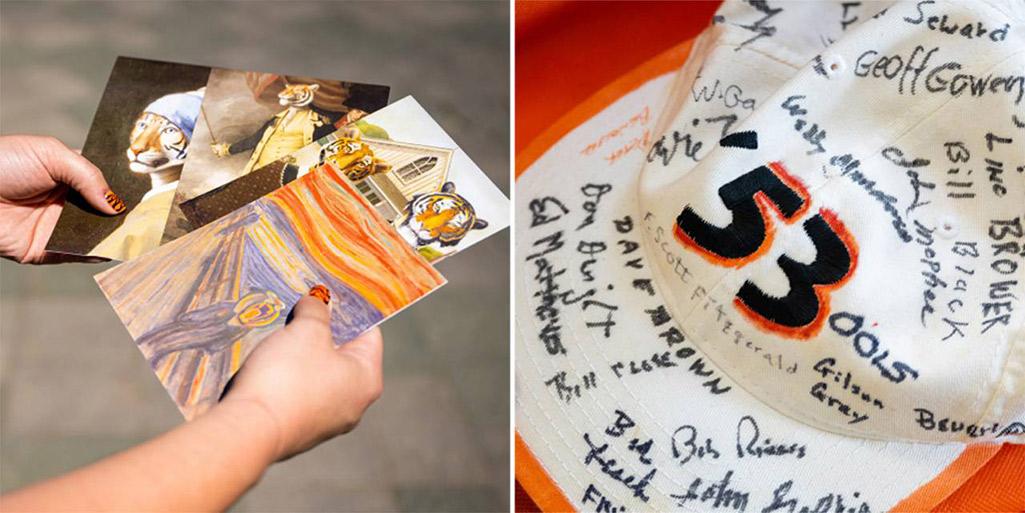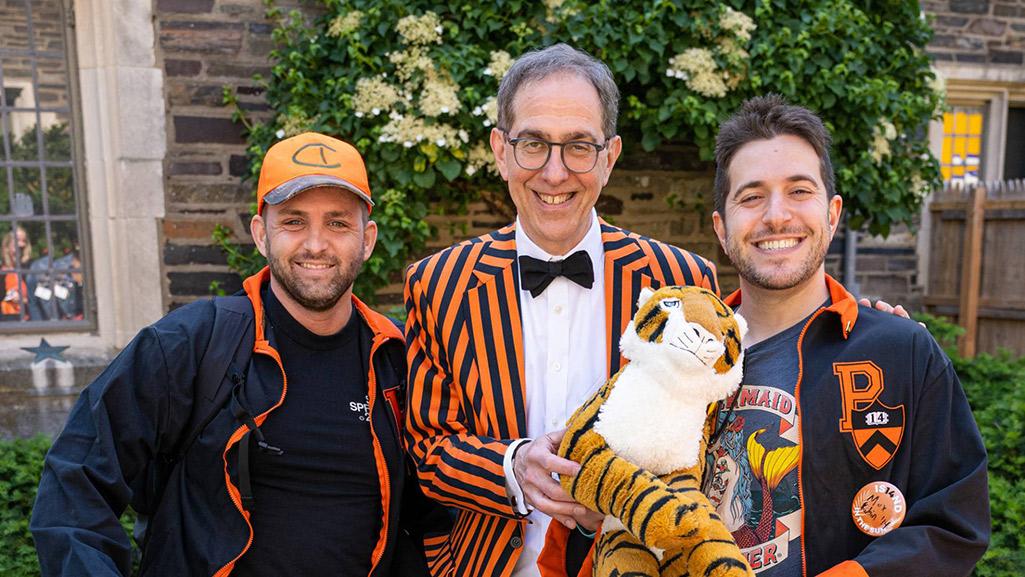The Princeton campus evolves and expands, the students walking through its arches and along its leafy paths change from year to year, but Reunions always highlights the one thing about Princeton that is immutable: that Tiger spirit.
Approximately 25,000 alumni, family, guests, faculty and staff, and the Class of 2023 followed in the footsteps of multitudes for this year’s Reunions, running Thursday, May 25, through Sunday, May 28. Under crisp, bright skies, they reminisced about the past, appreciated the new sights on campus, and soaked up the many unforgettable experiences that can only be had at a Princeton Reunions.

Photo by Denise Applewhite, Office of Communications
Many “Old Guard” members returned, including two of the contingent’s oldest members — 108-year-old Joe Schein, Class of 1937, who came from New York City to lead the P-rade, and 104-year-old Rev. Donald Fletcher, Class of 1939 and a 1951 graduate alum, who lives in Voorhees, New Jersey.
Graduates traveled from as far as Japan and Singapore and all over the nation and globe to reunite with classmates, tour old stomping grounds, survey Princeton’s expansion, gather for community service projects, and take in a variety of lectures, live music and events.
“It’s great to have everyone feel that Tiger spirit that hopefully encourages them to have an ongoing relationship with the University,” said Jennifer Daniels, Reunions co-chair for the Class of 1993. “You see me back at Reunions every year because it’s not just about seeing my classmates. It’s about seeing five generations of Princetonians who I’ve gotten to know over the years and celebrating those shared connections. Those are really hard to find anywhere else.”
Recalling the past, welcoming the future
This year, the Class of 1993 became the first to celebrate Reunions at the recently opened Yeh College and New College West. Their classmate, Kwanza Jones, and her husband José E. Feliciano, Class of 1994, announced in 2020 a major gift to the University and two dorms in New College West were named in their honor, which alumni were able to tour during this weekend’s events.

Photos by Sameer A. Khan/Fotobuddy
Many alumni remarked upon the changes to the campus since previous visits, including the addition of the new residential colleges, the construction of facilities for environmental science and engineering, and the rapidly expanding structure of the new Princeton University Art Museum. James Steward, the Nancy A. Nasher-David J. Haemisegger, Class of 1976, Director, Princeton University Art Museum, sat for a discussion with University Architect Ron McCoy, a 1980 Princeton graduate alumnus, and also gave tours around the perimeter of the museum site.
Mac Muirhead, Class of 2003, recalled having played lacrosse along Washington Road where the new Meadows Graduate Housing is nearing completion.
“Everything is amazing — there’s just so much more of it,” he said, gazing across Pardee Field, where his class was situated for the weekend. “The campus has changed, but I don’t think the spirit of Princeton has changed one bit.”
Among the major classes present were the Class of 1973, celebrating its 50th Reunions. Theirs was Princeton’s first class to which women were admitted as first-year students and who spent their entire four years on campus. “As I like to say, we were the class that changed the face of Princeton,” said class co-chair Macie Hall.
Reflecting the same era of cultural change, the American Whig-Cliosophic Society commissioned a portrait of Tina Ravitz, Class of 1976, the society’s first female president, which it unveiled on Friday in Whig Hall’s historic Senate Chamber. The portrait was painted by renowned artist Simmie Knox, who also painted a portrait of Carl Fields, the University’s first Black academic administrator, which hangs in Morrison Hall.
A life of the mind never ends
This year’s alumni-faculty forums offered opportunities to take quick dives into timely topics with faculty and alumni experts. Panel discussions explored national security, presidential fitness, the Supreme Court, contemporary medical care, and the impact of rapidly changing technologies.
A panel on economic development and urban inequality examined the challenges of big cities from multiple perspectives. The panel was moderated by Frederick Wherry, vice dean for diversity and inclusion in the Office of the Dean of Faculty, and the Townsend Martin, Class of 1917, Professor of Sociology, who earned his M.P.A. from Princeton in 2000 and a Ph.D. in 2004.

Among the observations made by panelists were ways to create opportunity within urban areas.
Carlton Brown, Class of 1973, principal and CEO of Direct Invest Development, called for cities to address failed policies of the past, including the 1934 Housing Act that redlined communities and the Federal-Aid Highway Act that created pockets of poverty.
“What we have to do is rethink and deconstruct those things that were constructed by government policy,” he said. “My approach is to create mixed-income, low-income housing, moderate-income housing, and market-rate housing, with opportunity structures in disinvested communities. … It’s about re-creating the fabric of communities, that it enables us to be self-actualized.”
Steve Adler, Class of 1978, and former mayor of Austin, Texas, said opportunity and access in cities today is mostly about affordability, particularly when it comes to housing. ”There are two things you can do,” Adler said. “You can either help make things cost less or you can help people have more money to spend in order to open up those doors.”
Leadership is needed to address the issue of gun violence, in particular, said Clifford Karchmer, Class of 1968, special studies director of Jefferson Waterman International. “We have a series of policy silos — law enforcement, medical, behavioral, mental health and emergency medical professionals and so forth,” Karchmer said. “Within the silos we’re doing quite well. The overarching capacity to encourage integration, coordination among those silos is not happening.”
Robert Doar, Class of 1983, and president of the American Enterprise Institute, shared his experience working in social services in the late 1990s in New York City, which he said led to better outcomes for children and families. “We were very invested in helping working families put together the resources they need to move up in opportunity,” he said. “Most of all and best of all, we had a very significant decline in child poverty.”
Natalie Tung, Class of 2018, shared her grassroots experience as co-founder and executive director of HomeWorks Trenton Inc. In her experience, she said, problems of opportunity are multi-faceted and require solutions that look at multiple factors, whether it’s access to reliable transportation or helping people to meet basic needs, such as being able to do laundry at home or nearby — both of which are issues that lead to chronic absenteeism in urban schools. “These things are so interrelated and so interlocked with each other,” she said. “I think all of the community organizations, all of our systems have to work better together in order to move this forward.”
(Re)uniting in service
Dozens of members of the classes of 1973, 1978, 1983, 1993, 2003, 2013, 2018 and the Association of Princeton Graduate Alumni convened at the Lewis Center for the Arts for service projects benefitting Kids Against Hunger, HomeWorks Trenton, and Womanspace. Together they filled 30,000 meal packages. They also assembled 48 backpacks and kits for HomeWorks Scholars’ first day of school.
Lloyd Price, Class of 1973, spent more than two hours pitching in for a Womanspace project. “You have to fill in gaps in the schedule,” Price said. “This was an easy choice.”
Brit Olsen, community engagement manager for Womanspace, said she enjoyed listening to members of different class years engage in conversation while taking part in a good cause. “They’re just incredible,” she said. “They have such great enthusiasm and energy.”
Reunions events will continue through the weekend. Dates and times for some marquee events are listed below, along with links to key visitor information.

Reunions events and visitor information
Reunions 2023 continues through Sunday. Highlights include:
- The P-rade throughout campus beginning at 2 p.m., Saturday, May 27;
- A conversation with President Christopher L. Eisgruber, Class of 1983, at 10:30 a.m., Saturday, May 27, in Richardson Auditorium;
- Performances by student groups including Fuzzy Dice, Koleinu, Princeton Nassoons, Old NasSoul, Roaring 20, Tigerlilies, Wildcats, Princeton University Ballet, Princeton Triangle Club, Princeton Katzenjammers, diSiac, Shere Khan, Tigressions and Footnotes;
- Exhibits in Firestone Library, Mudd Library, Stokes Library, Art@Bainbridge, Art on Hulfish, Maclean House, and Bernstein Gallery in Robertson Hall; and
- The University Orchestra concert at 8 p.m. and fireworks at 9:15 p.m., Saturday, May 27, at Princeton Stadium. Alumni can visit the Reunions 2023 website for the full schedule of events, for registration information — pre-registration is required this year before arriving on campus — for check-in locations to pick up wristbands, and for parking and transportation information.
Events information also is available for Reunions registrants through the Princeton University Events App, which can be downloaded through the iOS App Store and Google Play.



